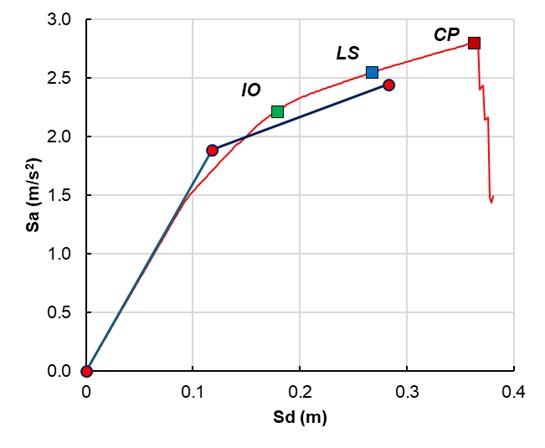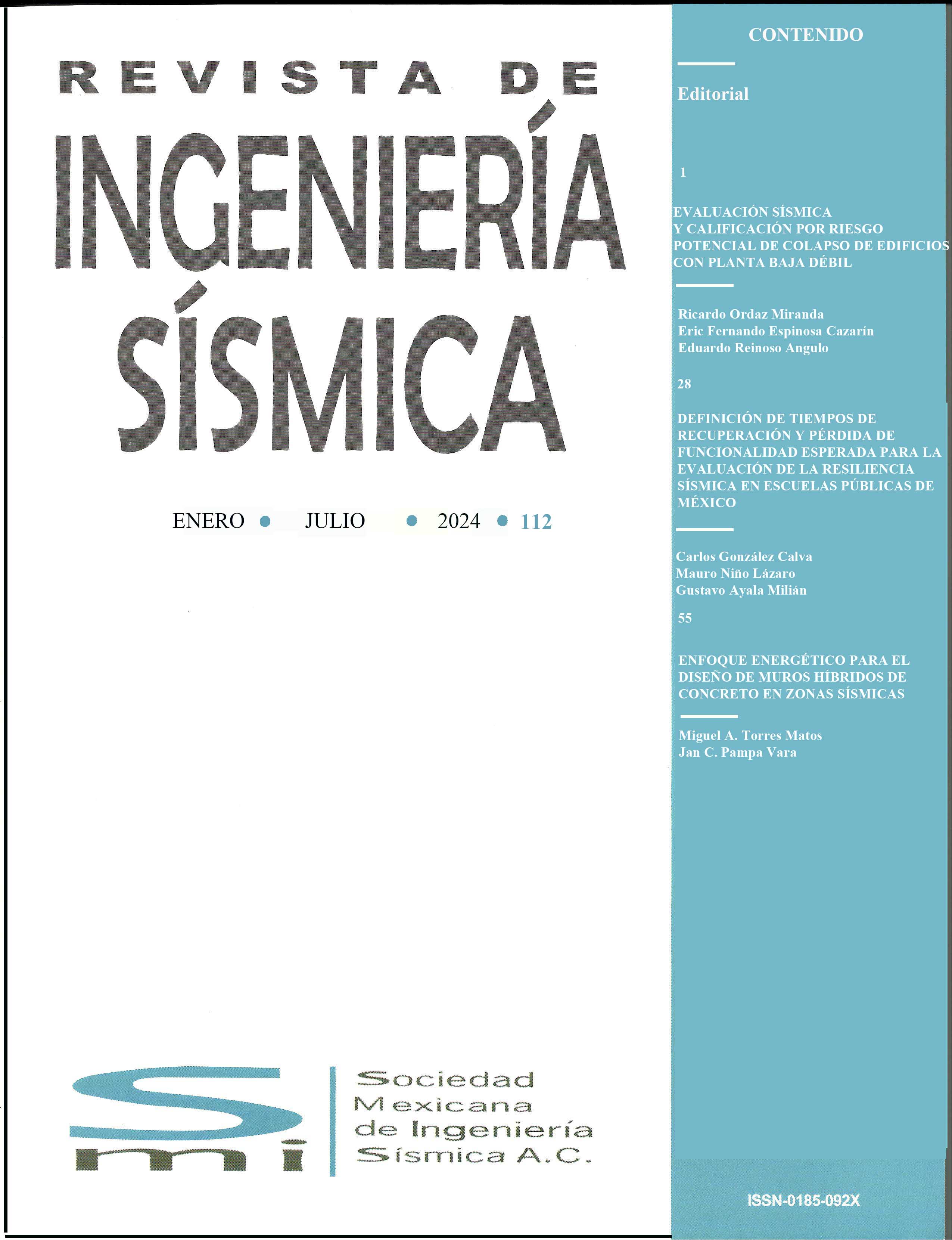A NEW SEISMIC DESIGN METHOD BASED ON LOCAL DISPLACEMENT CONTROL AND DAMAGE DISTRIBUTION
DOI:
https://doi.org/10.18867/ris.114.689Keywords:
displacement-based design, local displacements, damage control, reference system, resilience-based designAbstract
This paper presents the proposal of a new displacement-based seismic design methodology for reinforced concrete structures, considering as design objectives the control of local displacements and damage distribution. This methodology is based on the hypothesis that the nonlinear response of a multi-degree of freedom system can be approximated by a single-degree of freedom reference system, generally associated with the fundamental mode or the mode with the highest participation factor. The response curve of the reference system is constructed from the results of two eigen analyses, corresponding to the undamaged (elastic) structure and the structure with an assumed damage distribution under design conditions. The inelastic displacement of the reference system is defined as a function of an allowable plastic rotation in the beams of the critical floor where the maximum drift occurs. The application of this design method is illustrated by the design of three reinforced concrete frames of 5, 8 and 12 stories. The results obtained with the method are compared with those obtained from non-linear dynamic analyses using the same data sets records that define the spectrum used for the design. The results show that the method ensures not only the fulfilment of the design objectives, but also the control of the local damage intensity and its global distribution. Finally, the advantages of the proposed method are highlighted, positioning it as a solid basis for resilience-based seismic design approaches.
Downloads
References
ASCE 47-17 (2017). Seismic Evaluation and Retrofit of Existing Buildings. American Society of Civil Engineers.
ATC 40 (1996). Seismic Evaluation and Retrofit of Concrete Buildings. Applied Technology Council, Redwood City, CA.
Ayala, A G (2001). “Evaluación del desempeño sísmico de estructuras–un nuevo enfoque”. Revista internacional de métodos numéricos. 17(3):285–303. http://hdl.handle.net/2099/4280
Ayala, A G, Castellanos, H y López, S (2012). “A displacement-based seismic design method with damage control for RC buildings”. Earthquakes and structures. 3(3_4):413-434. http://doi.org/10.12989/eas.2012.3.3_4.413
Bertero, V V y Bozorgnia, Y (2004). Earthquake Engineering: From Engineering Seismology to Performance-Based Engineering. CRC Press.
Buendía, L M y Reinoso, E (2019), “Análisis de los daños en viviendas y edificios comerciales durante la ocurrencia del sismo del 19 de septiembre de 2017”, Revista de Ingeniería Sísmica, SMIS. No. 101. pp. 19-35. https://doi.org/10.18867/ris.101.508
Calvi, G M y Kingsley, G R (1995). “Displacement-based seismic design of multi-degree-of-freedom bridge structures”. Earthquake engineering and structural dynamics. 24(9):1247-1266. http://doi.org/10.1002/eqe.4290240906
Chopra, A K y Goel, R K (2001). “Direct Displacement-Based Design: Use of Inelastic vs Elastic Design Spectra”. Earthquake Spectra. 17(1):47-64. http://doi.org/10.1193/1.1586166
Fajfar, P (2000). “A Nonlinear Analysis Method for Performance-Based Seismic Design”. Earthquake Spectra. 16(3):573-592. http://doi.org/10.1193/1.1586128
Fajfar, P y Gašperšič, P (1996). “The N2 Method for the Seismic Damage Analysis of RC Buildings”. Earthquake engineering and structural dynamics. 25(1):31-46. http://doi.org/10.1002/(sici)1096-9845(199601)25:1%3C31::aid-eqe534%3E3.0.co;2-v
FEMA 356 (2000). Prestandard and Commentary for the Seismic Rehabilitation of Buildings. Federal Emergency Management Agency, Washington DC.
FEMA P58–3 (2018). Seismic Performance Assessment of Buildings-Volume 3: Supporting Electronic Materials. Federal Emergency Management Agency, Washington, DC.
FIB (2003). Displacement-based seismic design of reinforced concrete buildings. International Federation for Structural Concrete.
Freeman, S A (1978). “Prediction of Response of Concrete Buildings to Severe Earthquake Motion”. American Concrete Institute, Spetial Publication. 55:589-606. http://doi.org/10.14359/6629
López, S y Ayala, M G (2013). “Método de diseño sísmico basado en desplazamientos para marcos de concreto reforzado”. Revista Ingeniería Sísmica, (88), 91–111. https://doi.org/10.18867/ris.88.11
Mazzoni, S, McKenna, F, Scott, M Y y Fenves, G (2006). “Open system for earthquake engineering simulation, user command-language manual, Report NEES grid-TR 2004–21”. Pacific Earthquake Engineering Research, University of California, Berkeley, CA. http://opensees.berkeley.edu
Miranda, E (1999), “Approximate Seismic Lateral Deformation Demands in Multistory Buildings”, Journal of Structural Engineering, Vol. 125, No 4, pp. 417-425. https://doi.org/10.1061/(ASCE)0733-9445(1999)125:4(417)
Moehle, J P (1992). “Displacement-Based Design of RC Structures Subjected to Earthquakes”. Earthquake Spectra. 8(3):403-428. http://doi.org/10.1193/1.1585688
Montoya, C L (2016). “A direct performance based seismic design method for irregular structures: applications to concrete structures”. Tesis de doctorado. Universitat Politècnica de Catalunya. http://hdl.handle.net/10803/404337
NTC-Evaluación y Rehabilitación (2023). Normas Técnicas Complementarias para la Evaluación y Rehabilitación Estructural de Edificios Existentes. Gaceta Oficial de la Ciudad de México.
NTC-Sismo (2023). Normas Técnicas Complementarias para el Diseño por Sismo. Gaceta Oficial de la Ciudad de México.
O'Reilly, G J y Calvi, G M (2019). “Conceptual seismic design in performance-based earthquake engineering”. Earthquake engineering and structural dynamics. 48:389-411. http://doi.org/10.1002/eqe.3141
Priestley, M J (1998). “Brief comments on elastic flexibility of reinforced concrete frames and significance to seismic design”. Bulletin of the New Zealand Society for Earthquake Engineering. 31(4):246-259. http://doi.org/10.5459/bnzsee.31.4.246-259
Priestley, M J N y Kowalsky, M J (2000). “Direct Displacement-Based Design of Concrete Buildings”. Bulletin of the New Zealand Society for Earthquake Engineering. 33(4): 421-444. http://doi.org/10.5459/bnzsee.33.4.421-444
Priestley, M J N, Calvi, G M y Kowalsky, M J (2007). Displacement Based Seismic Design of Structures. IUSS Press, Pavia.
Wenbin, L y Jiaru, Q (2002). “Rules of drift decomposition and drift-based design of RC frames”. Advances in Building Technology. 311-318. http://doi.org/10.1016/b978-008044100-9/50039-5

Downloads
Published
How to Cite
Issue
Section
License
Copyright (c) 2025 Journal Earthquake Engineering

This work is licensed under a Creative Commons Attribution-NonCommercial 4.0 International License.





